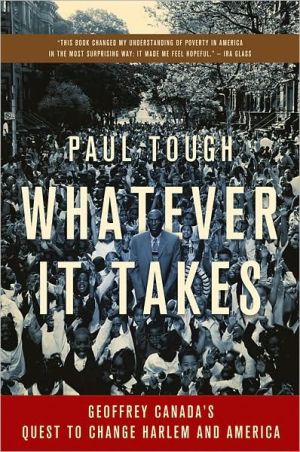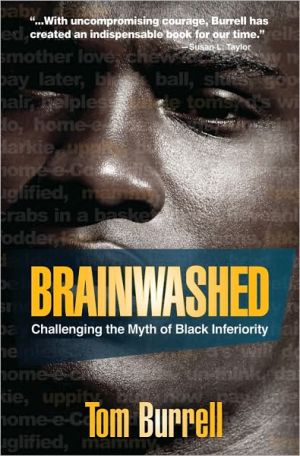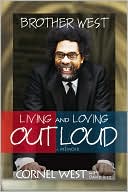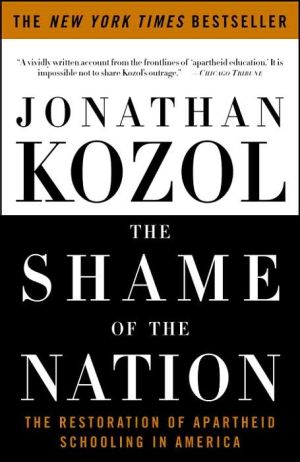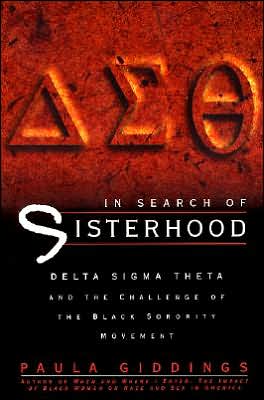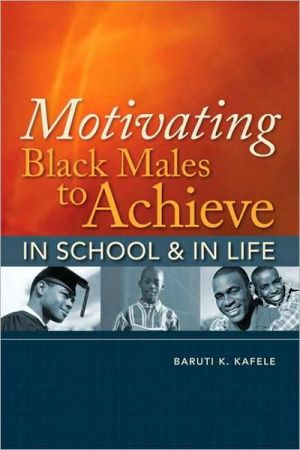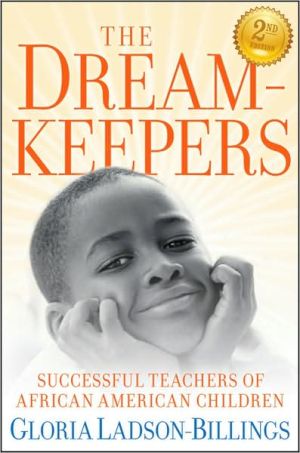Whatever It Takes: Geoffrey Canada's Quest to Change Harlem and America
That was the question Geoffrey Canada found himself asking. What would it take to change the lives of poor children - not one by one but in big numbers, and in a way that could be replicated nationwide? The question led him to create the Harlem Children's Zone, a ninety-seven-block laboratory in central Harlem where he is testing new and sometimes controversial ideas about poverty in America. His conclusion: if you want poor kids to be able to compete with their middle-class peers, you need...
Search in google:
What would it take?That was the question that Geoffrey Canada found himself asking. What would it take to change the lives of poor children—not one by one, through heroic interventions and occasional miracles, but in big numbers, and in a way that could be replicated nationwide? The question led him to create the Harlem Children’s Zone, a ninety-seven-block laboratory in central Harlem where he is testing new and sometimes controversial ideas about poverty in America. His conclusion: if you want poor kids to be able to compete with their middle-class peers, you need to change everything in their lives—their schools, their neighborhoods, even the child-rearing practices of their parents.Whatever It Takes is a tour de force of reporting, an inspired portrait not only of Geoffrey Canada but of the parents and children in Harlem who are struggling to better their lives, often against great odds. Carefully researched and deeply affecting, this is a dispatch from inside the most daring and potentially transformative social experiment of our time.The New York Times - Linda Perlstein…when it comes to an introduction to the debate about poverty and parenting in urban America, you could hardly do better than Tough's book. The children of the uneducated and impoverished too often bear a gloomy inheritance, their futures set in stone from an early age. Within Canada's 97 blocks, Tough finds a different kind of legacy—one shaped by parents who have learned to pay attention to their children's developmental needs. With a support network unlike anything else in America, the children of Harlem can envision a future so many others expect as a matter of course.
B y the time Geoffrey Canada arrived at the Promise Academy lottery, the auditorium was almost full. He had expected a modest turnout—he figured the rain would keep a lot of parents away—but by 6:00 p.m. more than two hundred people had crowded into the back of the hall, and there were dozens more still streaming in the front door. Here and there, members of Canada’s staff were consulting clipboards and calming anxious parents. His director of education hurried past him, shouting into her cell phone. It was April 14, 2004, a cool, wet night in Harlem. The hand-lettered sign out front of PS 242, streaked with raindrops, said "Welcome to the Promise Academy Charter School Lottery," and inside, past the sign-in table set up in the school’s front hallway, a tall, bull-chested young man named Jeff was handing a rose to each woman as she walked in. "These are for the moms," he said with a smile. "Welcome to the ceremony."\ Canada, a tall, thin black man in a dark blue suit, surveyed the crowd. From what he could see, the parents taking their seats in the auditorium were the ones he had hoped to attract: typical Harlem residents, mostly African American, some Hispanic, almost all poor or working class, all struggling to one degree or another with the challenges of raising and educating children in one of New York City’s most impoverished neighborhoods. In many ways, their sons and daughters were growing up the way Canada had, four decades before, just a few miles away in the South Bronx: cut off from the American mainstream, their futures constrained by substandard schools, unstable families, and a segregated city.\ Five years earlier, frustrated by Harlem’s seemingly intractable problems, Canada had embarked on an outsized and audacious new endeavor, a poverty-fighting project that was different from anything that had come before it. Since 1990, he had been the president of a well-respected local non profit organization called the Rheedlen Centers for Children and Families, which operated a handful of programs in upper Manhattan targeted at young people: afterschool drop-in centers, truancy prevention, antiviolence training for teenagers. They were decent programs, and they all did some good for the kids who were enrolled in them. But after Canada had been running them for a few years, day in and day out, his ideas about poverty started to change.\ The catalyst was surprisingly simple: a waiting list. One Rheedlen afterschool program had more children who wanted to enroll than it was able to admit. So Canada chose the obvious remedy: he drew up a waiting list, and it quickly filled with the names of children who needed his help and couldn’t get it. That bothered him, and it kept bothering him, and before long it had him thinking differently about his entire organization. Sure, the five hundred children who were lucky enough to be participating in one of his programs were getting help, but why those five hundred and not the five hundred on the waiting list? Or why not another five hundred altogether? For that matter, why five hundred and not five thousand? If all he was doing was picking some kids to save and letting the rest fail, what was the point?\ Canada became less and less sure of what his programs really added up to. Each one was supported by a separate short-term grant, often on a contract from one city agency or another, and in order to keep the money fl owing, Canada was required to demonstrate to the foundations and agencies that paid for the programs that a certain number of children had par tic i pated. But no one seemed to care whether the programs were ac tually working. In fact, no one seemed to have given a whole lot of thought to what, in this context, "working" might really mean.\ Canada began to wonder what would happen if he reversed the equation. Instead of coming up with a menu of well-meaning programs and then trying to figure out what they accomplished and how they fit together, what if he started with the out comes he wanted to achieve and then worked backward from there, changing and tweaking and overhauling programs until they actually produced the right results? When he followed this train of thought a little further, he realized that it wasn’t the out comes of individual programs that he really cared about: what mattered was the overall impact he was able to have on the children he was trying to serve. He was all too familiar with the "fade-out" phenomenon, where a group of needy kids are helped along by one program or another, only to return to the disappointing mean soon after the program ends. Head Start, the government-funded prekindergarten program for poor children, was the classic example. Plenty of studies had determined conclusively that graduates of Head Start entered kindergarten ahead of their inner-city peers. And plenty of studies had shown that a few years later, those same graduates had slipped back to the anemic achievement level of neighborhood kids who hadn’t attended Head Start. A few years of bad schooling and bad surroundings were powerful enough to wipe out all of the program’s gains.\ Canada wanted to find a way off the treadmill. So he asked himself a series of questions, and gradually his thinking took shape.
1 The Lottery 12 Unequal Childhoods 213 Baby College 534 Contamination 985 Battle Mode 1266 Bad Apples 1557 Last Chance 1748 The Conveyor Belt 1889 Escape Velocity 21310 Graduation 23411 What Would It Take? 257Acknowledgments 271Notes 276Index 286
\ Donna FooteCanada called his crusade the Harlem Children's Zone and chose a 24-block section of Harlem as his laboratory. Paul Tough, an editor at the New York Times Magazine, began tracking the effort in 2003. The result is Whatever It T akes, a you-are-there recording of the project's development, amazing growth and potential promise—and an informed primer on the correlation between race, poverty and the achievement gap in America. This is a serious book about a pressing issue, but Tough manages to make it an easy read with a cast of sympathetic characters…We don't know how this story will end. Time will tell if Geoffrey Canada has hit on what it will take to break the cycle of poverty in America. In the meantime, there are lessons to be learned from the Harlem Children's Zone—about the power of an idea, the role culture plays in student achievement, accountability, the indomitable human spirit. This book should be on every policymaker's reading list.\ —The Washington Post\ \ \ \ \ Linda Perlstein…when it comes to an introduction to the debate about poverty and parenting in urban America, you could hardly do better than Tough's book. The children of the uneducated and impoverished too often bear a gloomy inheritance, their futures set in stone from an early age. Within Canada's 97 blocks, Tough finds a different kind of legacy—one shaped by parents who have learned to pay attention to their children's developmental needs. With a support network unlike anything else in America, the children of Harlem can envision a future so many others expect as a matter of course.\ —The New York Times\ \ \ Publishers WeeklyNew York Times journalist Tough profiles educational visionary Geoffrey Canada, whose Harlem Children's Zone-currently serving more than 7,000 children and encompassing 97 city blocks-represents an audacious effort to end poverty within underserved communities. Canada's radical experiment is predicated upon changing everything in these communities-creating an interlocking web of services targeted at the poorest and least likely to succeed children: establishing programs to prepare and support parents, a demanding k-8 charter school and a range of after-school programs for high school students. Tough adeptly integrates the intensely personal stories of the staff, students and teachers of the Children's Zone with expert opinions and the broiling debates over poverty, race and education. The author's admiration for Canada and his "social experiment" is obvious yet tempered by journalistic restraint as he summarizes the current understanding of the causes of poverty and academic underperformance-and their remedies. Smoothly narrated, affecting and heartening, this book gives readers a solid look at the problems facing poor communities and their reformers, as well as good cause to be optimistic about the future. (Sept.)\ Copyright © Reed Business Information, a division of Reed Elsevier Inc. All rights reserved.\ \ \ \ \ Kirkus ReviewsNew York Times Magazine editor Tough profiles an ambitious effort to simultaneously address the seemingly eternal societal problems of poverty, class stratification, educational underachievement and racial discrimination. Frustrated by the limited number of people he could help in his job at a nonprofit organization providing services for at-risk youth, Geoffrey Canada in 1999 founded a large-scale initiative eventually dubbed the Harlem Children's Zone. He believed that to truly make a difference in a disadvantaged community, he must provide comprehensive services to residents from birth (or earlier) until death. With money raised privately as well as from government entities, Canada formulated programs providing prenatal care, instruction in parenting skills, early childhood education, K-12 schooling and help with the college-application process. The breadth and depth of his vision was either breathtaking or breathtakingly impractical, depending on your point of view. The author, though obviously an admirer, delineates the problems with Canada's program theory and its implementation as well as the strengths. While doing so, he moves seamlessly among three areas, situating accounts of Canada's life and policies within the larger context of previous movements to alleviate the consequences of poverty, class and race. Tough shows even the most naive reader how difficult it is to grapple with the question of how to take an entire community of mostly disadvantaged children and mostly undereducated parents without financial resources and transform them-or at least the children as they grow-into fully functioning members of the middle class. To the extent that Canada is succeeding, the authorattributes a portion of the victory to his ability to appeal to donors and volunteers across the political spectrum. Neither Democrats nor Republicans nor independents can articulate sound reasons to oppose this visionary socioeconomic experiment. Outstanding literary nonfiction, distinguished by in-depth reporting, compelling writing and deep thinking. Agent: David McCormick/Collins McCormick\ \ \ \ \ From the Publisher“As Paul Tough shows, Canada is a man who knows what it takes to ensure that every child has a fair shot in life.”—Bill Clinton\ "Paul Tough shows, from the inside, how the nation's most important work gets done." Adrian Nicole Leblanc\ “Powerful and hopeful, disturbing and daring, it’s one important book. Essential even.”—Alex Kotlowitz\ “Paul Tough takes on one of the biggest questions going: how do you teach people to be successful?”—Stephen Dubner\ “[A] moving account of . . . giving Harlem’s children access to the same dreams as children in New York’s most privileged neighborhoods.”—Marian Wright Edelman\ "[E]asily the most compelling and potentially the most important book on the problem of poverty in urban America in years."—Michael Pollan\ "[A] must-read for any American committed to solving our nation's greatest social injustice"—Wendy Kopp, Teach for America\ “The question of whether these terribly disadvantaged kids will fail or succeed takes on all the nail-biting urgency of any high-stakes, novelistic thriller.”—Elizabeth Gilbert\ “[This] account of this visionary man in Harlem changed my understanding of poverty in America it made me feel hopeful.”—Ira Glass\ " [T]his book gives readers a solid look at the problems facing poor communities and their reformers, as well as good cause to be optimistic about the future."\ Publishers Weekly\ "Outstanding literary nonfiction, distinguished by in-depth reporting, compelling writing and deep thinking." Kirkus Reviews, Starred\ "A remarkable book ... a story more gripping and inspiring than you'd imagine social policy could possibly be." Gentleman's Quarterly\ "This unflinching book will motivate us all to take action and make our schools places of possibility and hope."—Essence\ "This is an engrossing look at a visionary man and a bold experiment" Booklist, ALA, Starred Review\ \ \
